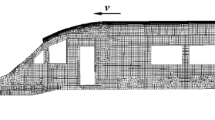Abstract
This paper analyses the design sensitivity of a suspension system with material and geometric nonlinearities for a motorcycle structure. The main procedures include nonlinear structural analysis, formulation of the problem with nonlinear dynamic response, design sensitivity analysis, and optimization. The incremental finite element method is used in structural analysis. The stiffness and damping parameters of the suspension system are considered as design variables. The maximum amplitude of nonlinear transient response at the seat is taken as the objective function during the optimization simulation. A more realistic finite element model for the motorcycle structure with elasto-damping elements of different material models is presented. A comparison is made of the optimum designs with and without geometric nonlinear response and is discussed.
Similar content being viewed by others
Abbreviations
- A:
-
amplitude of the excitation function
- a 0,a 1 :
-
time integration constants for the Newmark method
- t+ΔtC s :
-
secant viscous damping matrix at timet+Δt
- tC T :
-
tangent viscous damping matrix at timet
- C:
-
linear part oftC T
- D 0 i :
-
initial value of thei-th design variable
- D i :
-
instanenous value of thei-th design variables
- t+ΔtF(t−1) :
-
total internal force vector at the end of iteration (i−1) and timet+Δt
- t+ΔtF (i−1) (NL) :
-
nonlinear part oft+ΔtF(i−1)
- f :
-
frequency of the excitation function
- t+ΔtK s :
-
secant stiffness matrix at timet+Δt
- tK T :
-
tangent stiffness matrix at timet
- K:
-
linear part oftK T
- \(^t \hat K_T \) :
-
effective stiffness matrix at timet
- L :
-
distance between the wheel centres
- M:
-
constant mass matrix
- m T :
-
number of solution time steps
- NC :
-
number of constraint equations
- Q:
-
nonlinear dynamic equilibrium equation of the structural system
- t+ΔtR:
-
external applied load vector at timet+Δt
- t e :
-
active time interval for the excitation function
- tU:
-
displacement vector of the finite element assemblage at timet
- \(^t \dot U\) :
-
velocity of the finite element assemblage at timet
- tÜ:
-
acceleration vector of the finite element assemblage at timet
- t+ΔtU(i) :
-
displacement vector of the finite element assemblage at the end of iterationi and timet+Δt
- \(^{t + \vartriangle t} \dot U\left( i \right)\) :
-
velocity vector of the finite element assemblage at the end of iterationi and timet+Δt
- t+ΔtÜ(i) :
-
acceleration vector of the finite element assemblage at the end of iterationi and timet+Δt
- ΔU(i) :
-
vector of displacement increments from the end of iteration (i−1) to the end of iterationi at timet+Δt
- V:
-
driving speed of motorcycle
- x:
-
vector of design variable
- δ():
-
quantities of variation
- ϕ0 :
-
objective function
- ϕ i :
-
i-th constraint equation
References
Arora, J.S.; Cardoso, J.B. 1989: A design sensitivity analysis principle and its implementation into ADINA.Comput. Struct. 32, 691–705
Arora, J.S.; Haug, E.J. 1979: Methods of design sensitivity analysis in structural optimization.AIAA J. 17, 970–974
Bathe, K.J. 1982:Finite element procedures in engineering analysis. New York: Prentice Hall
Bathe, K.J.; Bolourchi, S.; Ramaswamy, S.; Snyder, M.D. 1978: Some computational capabilities for nonlinear finite element analysis.J. Nucl. Engng. Design 46, 429–455
Bathe, K.J.; Cimento, A.P. 1980: Some practical procedure for the solution of nonlinear finite element equations.Comp. Meth. Appl. Mech. Engng. 22, 59–85
Cardoso, J.B.; Arora, J.S. 1992: Design sensitivity analysis of nonlinear dynamic response of structural and mechanical systems.Struct. Optim. 4, 37–46
Dahlberg, T. 1980: Comparison of ride comfort criteria for computer optimization of vehicles travelling on randomly profiled roads.Vehicle System Dynamics 9, 291–307
Demić, M. 1989: Optimization of the characteristics of the elastodamping elements of passenger car by means of modified Nelder Mead method.Int. J. of Vehicle Design 10, 136–152
Fox, R.L. 1971: Optimization methods for engineering design.Addison-Wesley
Fukushima, N.; Hidaka, K.; Iwata, K. 1983: Optimum characteristics of the automotive shock absorbers under various driving conditions and road surfaces.JSAE Rev. 62–67
Haririan, M.; Cardos, J.B.; Arora, J.S. 1987: Use of ADINA for design optimization of nonlinear structures.Comput. Struct. 26, 123–133
Kumar, V.; Lee, S.J.; German, M.D. 1989: Finite element design sensitivity analysis and its integration with numerical optimization techniques for structure design.Comput. Struct. 32, 883–897
Lin, Y.T.; Chung, T.T.; Sun, T.C. 1992: Dynamic response optimization of nonlinear structures with viscous damping effects for design-dependent cyclic loads.Comput. Struct. 45, 461–469
Lu, X.P.; Li, H.L.; Papalambros, P. 1984: A design procedure for the optimization of vehicle suspensions.Int. J. of Vehicle Design 5, 129–142
Kirsch, U. 1981:Optimum structural design. New York: McGraw Hill
Potter, R.A.; Willmert, K.D. 1973: Optimum design of vehicle suspension system.ASME, 73-DET-46
Ryu, Y.S.; Haririan, M.; Wu, C.C.; Arora, J.S. 1985: Structure design sensitivity analysis of nonlinear response.Comput. Struct.,21, 245–255
Stricklin, J.A.; Haisler, W.E.; von Riesemann, W.A. 1973: Evaluation of solution procedures for material and/or geometrically nonlinear structural analysis.AIAA J. 11, 292–299
Tseng, C.H.; Arora, J.S. 1989: Optimum design of systems for dynamics and controls using sequential quadratic programming.AIAA J. 27, 1793–1800
Wu, C.C.; Arora, J.S. 1987: Design sensitivity analysis of nonlinear response using incremental procedure.AIAA J. 25, 1118–1125
Author information
Authors and Affiliations
Rights and permissions
About this article
Cite this article
Sun, T.C. Design sensitivity analysis and optimization of nonlinear dynamic response for a motorcycle driving on a half-sine bump road. Structural Optimization 11, 113–119 (1996). https://doi.org/10.1007/BF01376854
Received:
Revised:
Issue Date:
DOI: https://doi.org/10.1007/BF01376854




